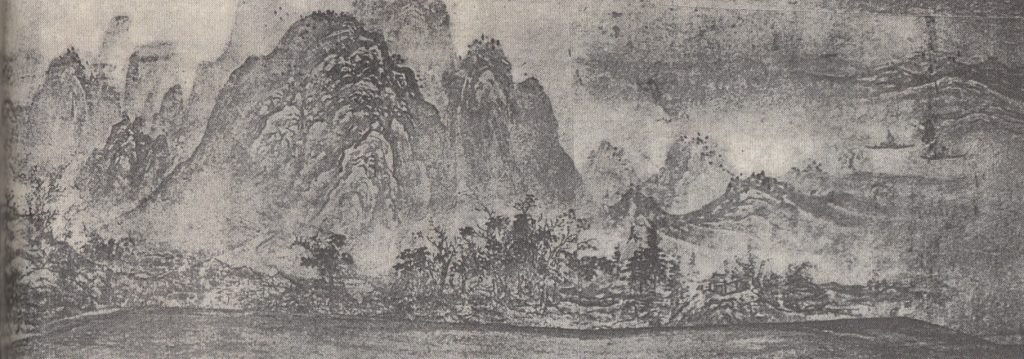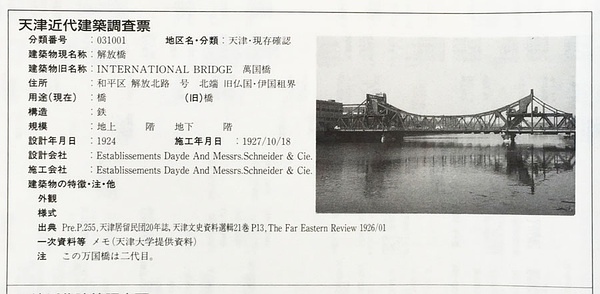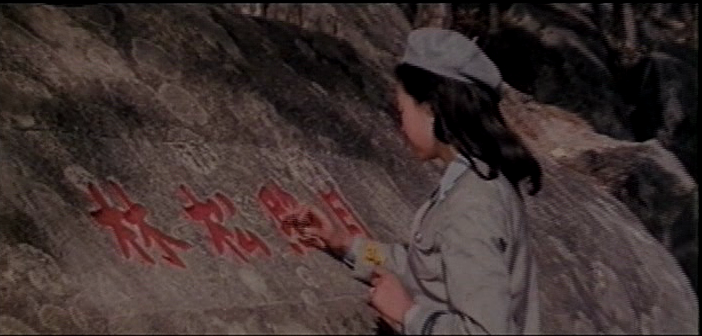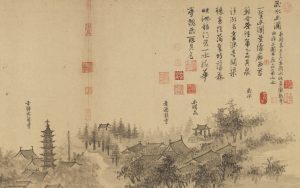Presentations
March 9, Deng Fei
Friday, March 9, 4:30 – 6:30 pm, CWAC 152
Popularized Landscapes: Pictures of Landscape in Tombs in Yuan China (1271—1368)
Professor Deng Fei
Associate Professor, National Institute for Advanced Humanistic Studies, Fudan University | Visiting Scholar, Harvard-Yenching Institute
Landscape painting on the north wall in Feng Daozhen’s tomb (1265) found in Datong, Shanxi
Landscape painting is generally recognized as the major category within China’s painting tradition. The visual representation of nature not only appears in art from above the ground, but also in tomb decorations under the earth. Many tombs, which depict images of landscape on their interior walls, have been found in North China during the thirteenth and fourteenth centuries. This talk will address these materials and answer the following question: why were these pictures chosen to surround the deceased? The study will investigate various pictorial contents of the landscape paintings as well as multiple roles and meanings they assumed. By considering landscape not simply as an object to be seen, but as an instrument of cultural force, I hope to probe the cultural, social, and religious environments in which the landscape motifs were developed.
Friday, March 9, 4:30 – 6:30 pm, CWAC 152
Persons with concerns regarding accessibility please contact Nancy P. Lin (nancyplin@uchicago.edu)
Feb. 1, Zhiyan Yang
Thursday, February 1, 5:00 – 7:00 pm, CWAC 152 (Please note the special day and time)
When Recent Past Became New History: Learning from a Historical Survey (1987-1991) of Modern Architecture in China
Zhiyan Yang
Department of Art History, University of Chicago
”International Bridge in Tientsin,” an index label from The Architectural Heritage of Modern China: Tianjin中国近代建築総覧総覧:天津篇 (1989)
From 1987 to 1991, a team comprised of both Chinese and Japanese architectural historians collaborated to survey the existing architecture built in between 1840s and 1940s among eighteen Chinese cities and compiled an extensive list of data. Known as the Comprehensive Study of Modern Architecture in China 中国近代建筑总览, the project has reinvigorated the field and remained foundational to this day. I argue that it is unique not only as a corpus of documentation, but also as a historic event in itself. The nature of the collaboration cultivated a changing attitude towards China’s architectural heritages, revealing negotiations between different cultural, linguistic, and historiographical traditions. By unfolding the processes of knowledge production, comparing publications from both the Chinese and Japanese sides, and questioning the historical connotations and intricacies behind them, I hope to shed new light on how the Chinese architectural world understood and adapted to the new challenges by reconsidering its recent architectural past as a critical site for modernization. Analyzing both text and image through a comparative perspective, I will also explain the project against background of a globalizing contemporary architectural culture in the 1980s and explore why this particular history has had a broader intellectual and social impact on the entire region of East Asia.
Thursday, February 1, 5:00 – 7:00 pm, CWAC 152
Persons with concerns regarding accessibility please contact Nancy P. Lin (nancyplin@uchicago.edu)
Jan. 26, Paola Iovene
Friday, January 26, 4:30 – 6:30 pm, CWAC 152 (Please note the room change from last quarter)
Landscape of Words: Stone Inscriptions in Romance on Lushan Mountain (1980)
Professor Paola Iovene
Associate Professor in Chinese Literature, Department of East Asian Languages and Civilizations , University of Chicago
Film still from Romance on Lushan Mountain (1980)
Considered “an iconic example of Chinese cinema from the Reform era,” Romance on Lushan Mountain (Lushan lian, 1980) was mostly shot on location in Autumn 1979. The gorgeous landscape of Lushan—its waterfalls and peaks enshrouded in clouds as well as its historical sites—underscores the growing affection between the protagonists and conveys a not-so-subtle vision of cultural nationalism in which love for the motherland and for ancient Chinese culture replaces party loyalty as markers of Chineseness in the early post-Mao era. This paper analyses the narrative function of recurrent shots of stone inscriptions, speculating on the significance of Chinese characters in cinema and on the concepts of landscape and location that emerge from this film.
Friday, January 26, 4:30 – 6:30 pm, CWAC 152
Persons with concerns regarding accessibility please contact Nancy P. Lin (nancyplin@uchicago.edu)
Jan. 12, Xi Zhang
Friday, January 12, 4:30 – 6:30 pm, CWAC 152 (Please note the room change from last quarter)
Riverscape Wrapped around Porcelain: A Historical Study of 18th-Century Chinese Export Porcelains in the AIC Collection
Xi Zhang
Department of Art History, University of Chicago
Punch Bowl, c. 1780. Courtesy of Art Institute of Chicago
This paper focuses on punch bowls, a particular porcelain form, also known as hong bowls that gained popularity in the 18th-century export market because of its massive size and capability to display on its surface the wrapped-around continuous riverscape of Guangzhou. Focusing on the Chinese export porcelains in the Art Institute of Chicago collection, I will take a close examination of punch bowls in the context of the architectural development in 18th-century Guangzhou, the relationship between the iconography of harbor views and the objects per se, and the experience of cross-cultural encounters in the 18th century China trade. By doing so, I hope this case study will shed some light on studies of the illusive genre of Chinese export objects and how best to understand them in the history of Chinese art.
Friday, January 12, 4:30 – 6:30 pm, CWAC 152
Persons with concerns regarding accessibility please contact Nancy P. Lin (nancyplin@uchicago.edu)
Dec. 1, Yifan Zou
Friday, December 1, 4:30 – 6:30 pm, CWAC 156
Traditions Reinterpreted: Text and Image in Wu Zhen’s Eight Views of Jiahe (1344)
Yifan Zou
Department of Art History, University of Chicago
Wu Zhen 吳鎮 (1280-1354), Eight Views of Jiahe 嘉禾八景 , 1344, ink on paper handscroll, 37.5 x 566 cm.
This paper explores the Yuan dynasty (1271-1368) painter Wu Zhen’s 吳鎮 (1280-1354) depiction of his hometown in Eight Views of Jiahe 嘉禾八景 (1344), a 37.5 x 566 cm paper handscroll with ink renderings of eight scenes and accompanying text. Despite several previous excursions into this scroll, I propose still another trip back to the Jiahe. Not only does the “hypnotic effect” of the “eight views” topic encourage a periodic retelling, but due to their different focuses, most previous studies have not examined the work’s text and images as a coherent whole. This paper will explore how different traditions—the tradition of the Eight Views, and the traditional relationship between map and text in Chinese gazetteers, especially Song dynasty tujing 圖經 (cartographic classics)—were reinterpreted in Wu Zhen’s Eight Views of Jiahe. The questions that can be raised from an exploration of this work are broader than might be expected. Could it help us discover how Wu Zhen—a painter who lived most of his life in obscurity—made his way around the territory? In what way did he translate knowledge from tujing to the Jiahe handscroll to make it an appealing fundraising tool for local site? Where can we pin this work on the spectrum from maps to landscape paintings? Finally, how might this work lead us to approach the question of professionalism in the realm of cartography before European cartographic techniques were introduced to China? While it is impossible to resolve these questions, this paper will attempt to contribute to them.
Friday, December 1, 4:30 – 6:30 pm, CWAC 156
Persons with concerns regarding accessibility please contact Nancy P. Lin (nancyplin@uchicago.edu)
WEDS. Nov. 16, Zhenru Zhou
Wednesday, November 15, 5:00 – 7:00 pm, CWAC 156
A Visual Study of the Front Panel of a Tang Dynasty Buddhist Shrine
Zhenru Zhou
Department of Art History, University of Chicago
Front panel of a Tang dynasty Buddhist shrine. Photo courtesy of Nelson-Atkins Museum of Art, Kansas City.
This paper is a contextual and visual study of the front panel of a Tang dynasty (618-907 CE) Buddhist shrine housed in the Nelson-Atkins Museum of Art, Kansas City (fig.1). I will first discuss the possible provenance and dating of this panel by comparing it with a group of “little dragon-and-tiger pagodas” (xiao longhu ta 小龙虎塔). Demonstrating that the architecture to which this panel was originally attached would have belonged to a type of small-sized sculpted pagodas in Henan and Shandong provinces dated back to the first half of the 8th century, I will further argue against the common idea that this type is an abbreviated and inferior version of the “dragon-and-tiger pagoda” type or the brick multi-eave pagoda type. Based on their unique formal characteristics, e.g. the twin-pagoda format, the multi-eave and slender profile, the single niche, the Pure Land imagery, the inscribed sutras and votive texts, I will argue that these pagodas were meant to be the miniaturized representation of the grandiose architecture of “seven-leveled stūpa” (qiji futu 七级浮屠), and that their media specificity may reflect a shifting conception of Buddhist monument during the High-Tang period in central China.
Wednesday, November 15, 5:00 – 7:00 pm, CWAC 156
Persons with concerns regarding accessibility please contact Nancy P. Lin (nancyplin@uchicago.edu)
Oct 27, LI Jian’an
Friday, October 27, 4:30 to 6:30pm, CWAC 156
从山林到海洋——福建古代陶瓷与海上丝绸之路
From the Mountain Forests to the Sea: Fujian Ancient Ceramics and the Maritime Silk Road
栗建安 LI Jian’an
福建博物院文物考古研究所, 所长 Director, Institute of Cultural Relics and Archeology, Fujian Museum
*Note: This talk will be delivered in Chinese
中国东南沿海的福建在半个多世纪以来的考古工作中,发现了自商代以降尤其是历史时期的众多古窑址,出土的唐宋元明清各个朝代的各类陶瓷器,与海上丝绸之路沿线上的沉船、港市遗址所遗存的大量福建陶瓷可相互映证,因此成为海上丝绸之路的重要历史见证、研究的珍贵实物资料,也证实了福建陶瓷在早期贸易全球化进程中的重要历史地位。
Friday, October 27, 4:30 to 6:30pm, CWAC 156
Persons with concerns regarding accessibility please contact Nancy P. Lin (nancyplin@uchicago.edu)
Oct 13, GU Zheng
Friday, October 13, 4:30 to 6:30pm, CWAC 156
Between Journalism and Propaganda: The Assassination of Song Jiaoren in Minglibao
GU Zheng 顾铮
Professor and Vice-Director of the Research Center for Visual Culture, School of Journalism, Fudan University
Visiting Scholar, Harvard-Yenching Institute
*Note: This talk will be delivered in Chinese
本文尝试检视作为民国初年革命党人主要喉舌的《民立报》对于武昌起义以及之后的重大新闻事件暗杀宋教仁案的视觉处理,探讨他们如何认识照片、尤其是肖像照片在新闻报导与政治宣传中的作用与使用方式。报人与革命党人的身份的重合,使得他们对于照片的使用达到了某种空前的水准,也令新闻与宣传的边界受到挑战,这在“刺宋案”中体现得尤为明显。
This event is sponsored by the Committee on Chinese Studies at the Center for East Asian Studies with generous support from a United States Department of Education National Resource Center Title VI Grant.
Friday, October 13, 4:30 to 6:30pm, CWAC 156
Persons with concerns regarding accessibility please contact Nancy P. Lin (nancyplin@uchicago.edu)
THURS. October 5, Adrian Favell
Thursday, October 5, 5-7pm, CWAC 156
After the Tsunami: Japanese Contemporary Art since 2011
Adrian Favell
Sainsbury Institute for the Study of Japanese Arts and Cultures, University of Leeds
Art collective Shibuhouse led by Saito Keita
What effect have the Triple Earthquake disasters of March 2011 had on Japanese contemporary art? Japanese contemporary art since the 1990s has mainly been associated with the popular culture inspired work of artists such as Murakami Takashi, Nara Yoshitomo, Mori Mariko and Aida Makoto. The rupture of 2011 however made clear a major shift in Japanese art towards more community based, socially engaged, and politically critical work, including among this older generation. While explaining the longstanding roots of socially engaged “art projects” as a distinctive feature of the Japanese art world, the talk will focus on the changing output of a younger generation of artists: particularly the rise of the art unit Chim↑Pom, and the story of three even younger Tokyo art collectives, whose work has also shifted the line between art, politics and everyday survival—Chaos★Lounge, Shibuhouse and Parplume. The talk is based on a new chapter for a forthcoming revised and updated edition (in Japanese and English) of my book, Before and After Superflat: A Short History of Japanese Contemporary Art 1990-2011 (Blue Kingfisher/DAP 2012).
This event is sponsored by the University of Chicago Center for East Asian Studies with support from a Title VI National Resource Center Grant from the United States Department of Education.
Thursday, October 5, 5-7pm, CWAC 156
Persons with concerns regarding accessibility please contact Nancy P. Lin (nancyplin@uchicago.edu)







